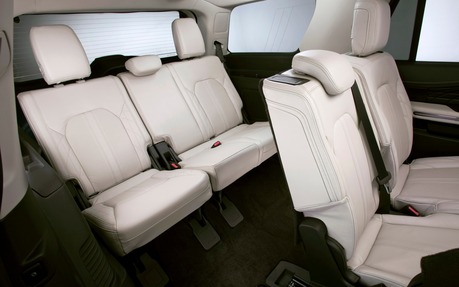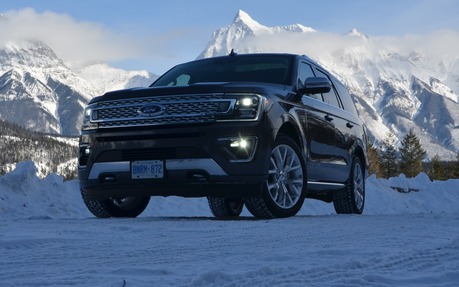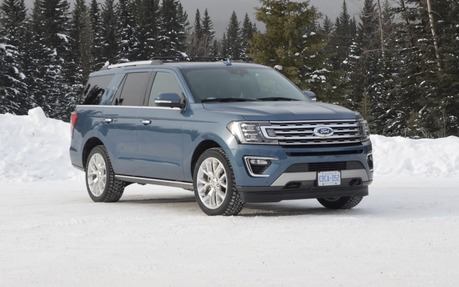2018 Ford Expedition: Why Pay More for a Lincoln Navigator?
The 2018 Expedition comes from the Ford division, and yet, it has the refinement of a Lincoln product. Oh, Ford was sure to equip it with a less powerful engine than the Lincoln Navigator to respect the hierarchy. With the aid of a sound level meter, you’d even be able to see that the Navigator offers a quieter ride than the Expedition. The Lincoln's materials are also more dignified and the presentation is more refined. And the Lincoln logo expresses affluence better than Ford’s proletarian oval.
The Expedition, Ford’s biggest SUV, comes in two versions: regular and extended wheelbase. The latter, known as the Max, makes the vehicle 28 centimetres longer. The additional space is reserved for baggage, with the trunk increasing from 566 to 1019 litres when the three rows of seats are upright.

Three actual rows
The third-row seats aren’t any bigger in the Max, but we’re not complaining. They provide sufficient room to sit comfortably and, unless you’re a basketball player, you won’t have to rest your knees against your forehead. As for the optional second-row captain’s chairs, they are very comfortable too, even after several hours. A bench comes standard, but we didn’t have the chance to test drive an Expedition equipped with one. The front seats are even more comfortable.
375 or 400 horsepower
Regardless of the length of the Expedition, there’s just one engine: the ubiquitous twin-turbo, 3.5-litre V6 that already equips vehicles as diverse as the F-150 and the GT sports car! In the Expedition, this V6 delivers 375 horsepower at 5000 rpm and a torque of 470 lb.-ft. at 3500 rpm in all versions, except the Platinum that benefits from 25 more horsepower and 10 more lb.-ft. of torque. Moreover, it reaches its torque peak a little sooner, at 3250 rpm, which improves passing performance.
The 10-speed automatic gearbox does an extraordinary job and you’d really have to nitpick to find fault with it. It allows the engine to only rev at 1600 rpm at 100 km/h (1900 in Sport mode—a confusing mode in an SUV of this size, but we’ll come back to that). At the wheel of the Limited version, on a highway and on secondary roads, we recorded an average fuel consumption of 13.3 L/100 km.
However, on a jaunt up a very steep forest road and through a small off-road circuit (very light off-roading, even a Focus could have done it without much difficulty), this figure quickly climbed to 15.7. That isn’t too shabby for such a big vehicle, but that proves that even if you can get a relatively economical ride from the Expedition (and from most of the full-size SUVs in the world, all manufacturers combined), it doesn’t take much for the fuel consumption to increase dramatically.
Almost an F-150
The Expedition is built on the same chassis as the F-150. The aforementioned mechanical features also come from this pickup, which is the most popular in Canada. And just like the F-150, the Expedition has an all-aluminum body, which helps it shed 136 kilograms compared to the previous generation. Don’t kid yourself, though—this is no featherweight, unless you think a feather weighs nearly 2700 kg. It can tow up to 9300 pounds (4219 kg) when equipped with the Towing Package, a $1,400 option.
On the road, the Expedition demonstrates poise, even in curves. Sure, you feel a little body roll, but it’s well within the acceptable range for such a big and heavy vehicle with a high centre of gravity. The steering could give a little more feedback and could be more direct, but don’t forget that this is not a Focus RS. The independent four-wheel suspension—the F-150 has a solid axle rear suspension—offers extra comfort. The optional Continuously Controlled Damping suspension offered on the Platinum version enhances comfort and makes the ride more dynamic. The 285/45R22 tires, which would make Bill Gates shed a tear if he had to replace them, have a lot to do with it!

Attention: Sport mode
Looking for more thrills? You can always select the Platinum version’s Sport mode. It makes the suspension firmer, modifies the electronic management of the engine, sharpens the reflexes of the gearbox and gives more tone to the steering. It definitely improves performance (you should hear the nice rumble of the V6 at wide-open throttle), but this mode will really be appreciated in mountainous areas. However, this Sport mode does not make the Expedition a Focus RS (I repeat).
The Expedition’s off-road capabilities are far superior to what the average Joe will ever need. A few contractors that have to deal with muddy or rocky terrain will get some fun out of it. For them, the FX4 option brings, among other things, special dampers, an electronic rear differential and skid plates.
So why buy a Navigator?
Other than these petty practical considerations, I wonder about the positioning of the Expedition and, more importantly, of the Navigator in the Ford/Lincoln lineup. Sure, the Navigator is more muscular, better finished and nicer in my opinion. Its base price is $89,600 (regular wheelbase). That of a Ford Expedition Platinum with regular wheelbase is $81,349. Poor old me thinks that the Ford is a better investment. What’s more, it can tow more than the 8400 pounds (3810 kilos) of the Navigator. But since it isn’t me that’s going to make your payments, the choice is yours.
Here are the Canadian MSRPs of the 2018 Ford Expedition:
- XLT (regular wheelbase only): $60,149
- Limited: $73,149
- Limited Max: $76,149
- Platinum: $81,349
- Platinum Max: $84,349
- Freight and delivery: $1,790
| Test drive report | |
| Test model | 2018 Ford Expedition |
|---|---|
| Trim level | Platinum 4x4 |
| Price range | $60,149 – $84,349 |
| Price as tested | CA$82,604 |
| Warranty (basic) | 3 years/60,000 km |
| Warranty (powertrain) | 5 years/100,000 km |
| Fuel economy (city/highway/observed) | 13.8 / 10.7 / 15.7 L/100km |
| Options | N/A |
| Competitive models | Chevrolet Suburban, Chevrolet Tahoe, GMC Yukon, Nissan Armada, Toyota Sequoia |
| Strong points |
|
| Weak points |
|
| Editor's rating | |
| Fuel economy | You don’t buy an Expedition for fuel economy |
| Comfort | Only the Lincoln Navigator is better in this area. |
| Performance | We weren’t able to do measured testing, but it has some juice, even with the 375-horsepower engine. |
| Infotainment | Once an example of what not to do, the SYNC 3 system is vastly improved and has become very user friendly. |
| Driving | It’s hard to talk about driving experience for a vehicle of this size, but the full-size SUV that is the most fun to drive. |
| Overall | Frankly, Ford hasn’t lost its touch when it comes to pickups and big SUVs! |
